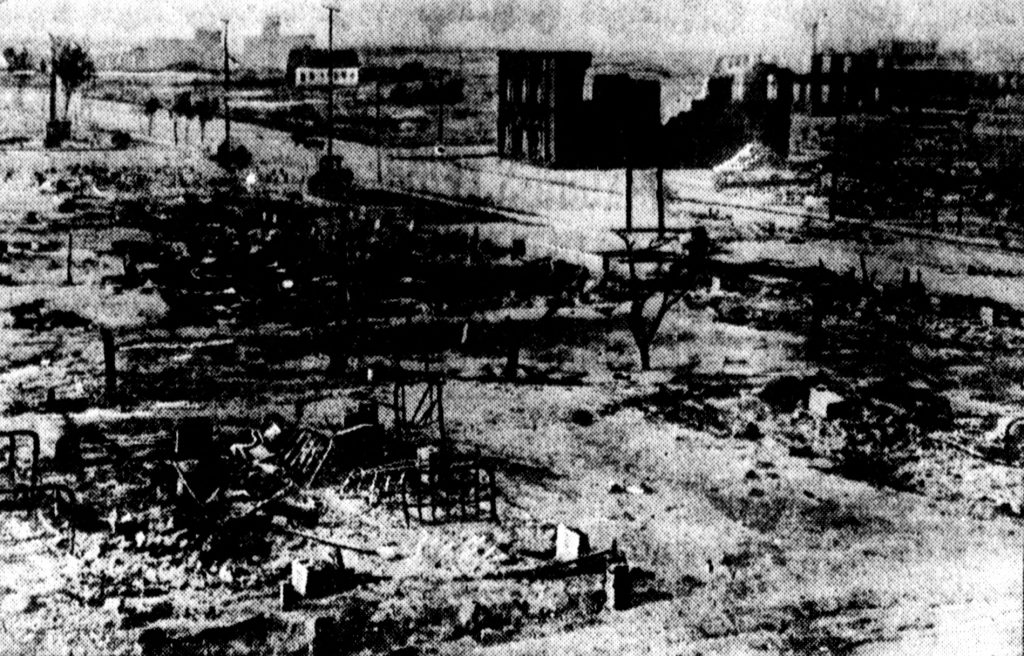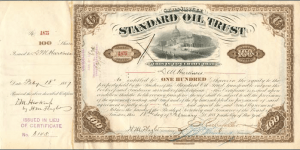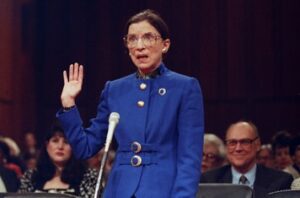Today Americans still debate what occurred between Dick Rowland and Sarah Page in the Drexel building elevator on downtown of Tulsa’s Main Street on May 30, 1921. Dr. Scott A. Ellsworth, a University of Michigan professor who teaches courses on African American history, Southern literature, and crime and justice in contemporary U.S. society, concludes that Rowland, to save himself from falling after tripping in an elevator on his way to the ‘colored’ bathroom, grabbed onto the first thing in his line of sight. That thing he caught happened to be the arm of a white elevator operator, Sarah Page.1
This encounter alarmed Page, causing her to scream. After hearing Page’s cry and seeing Rowland flee from the elevator, an unknown white store clerk called the police to report an attempted assault. The following day, May 31, police arrested 19-year-old Rowland based on accusations from both Ms. Page and the clerk. In none of the accounts studied today is there evidence that Rowland attempted to assault Page.2 Although we agree on this fact today, Tulsans at the time believed the rumors published by local newspapers that Rowland had attacked, and even attempted to rape Page, “scratching her hands and ripping her clothes.”3 This incident became the catalyst for one of the worst race riots in American history. And shockingly, this story does not usually appear in history textbooks.
Dick Rowland, born Jimmie Jones, lived with his two orphaned sisters in Vinita, Oklahoma during his childhood. Their birthplace is unknown. An African American woman by the name of Damie Ford informally adopted Jones by the time he was six years old. By 1909, Jones and Ford had moved to Tulsa to join Ford’s family, the Rowlands, where he then adopted their surname and chose his own first name, Dick.4

Greenwood in Tulsa, Oklahoma, established as a town in the early 1900s, still abided by the laws of Jim Crow and segregation even though it had a lot of independent African American economic activity.5 Rowland began his schooling in Tulsa, then later dropped out of Booker T. Washington High School at the age of 19 to work at a white-owned parlor as a shoe shiner. This behavior was not unusual seeing as a shoe shiner in Tulsa, whether African American or white, could get a tip anywhere from $1-$5, which was decent money in the early twentieth century. Greenwood district in Tulsa, with over 6,000 residents, black-owned businesses, schools, hospitals, newspapers, staffed with African American professionals, was one of the most prosperous African American communities in the country at the time.6

At approximately 3:15 PM on the day of Rowland’s trial, the Tulsa Tribune published and released the article “Nab Negro for Attacking Girl in Elevator” to the general public. At this time, the Tulsa Tribune was a Republican paper, edited and published since 1919 by the controversial racist Richard Lloyd Jones. This inflammatory article gave Rowland the pejorative nickname “Diamond Dick” and strongly implied that Rowland had raped Sarah Page. This issue also published an editorial warning titled “To Lynch a Negro Tonight,” which started the rumor that Rowland would be lynched that night. This rumor, in addition to others stirred up by the publishings of the Tulsa Tribune, fueled high emotion in the surrounding community.7 This build-up of concern, confusion, and anger ravaged the community and led to the gathering of armed white World War I veterans to rally for Rowland being put in jail, alongside African American locals anxious that the boy would be killed over a misunderstanding. The two groups gathered outside of the courthouse where Rowland’s case was held. Around 8:20 PM, the crowd grew, and so did the tension. Shots were fired, and twelve people were killed within the hour. These shots began a riot that would continue for the next sixteen hours.8
As witnesses later recounted the events of that night, they argued that the white rioters had forgotten about Dick Rowland entirely, and their motivation became to “settle for nothing less than scorched earth. They would not be satisfied to kill the Negroes, or to arrest them. They would also try to destroy every vestige of black prosperity.”9 The Tulsa Race Race Riot was the first race riot of its kind in America. The violence and vandalism resulted in upwards of 300 people killed, with most being African American. Even the goal of the Tulsa police on the night of May 31, was to “put down a negro uprising.”10 The police department, in tandem with local units of the National Guard, worked to disarm Greenwood residents and swept through the town.

By the afternoon of June 1, the vandalism escalated to burning down the neighborhood, and the city was placed under martial law.11 This stopped the physical violence, however, reverberations continued for years to come. More than 35 blocks, including 1,256 residences of the African American neighborhood of Greenwood in Tulsa had burned almost out of existence. Virtually every African American person from this area was now homeless, and the displaced were held in custody in internment centers. White rioters were sent home by police and National Guard, and were never held accountable for any destruction of the town.12
The case against Rowland was dismissed by September of 1921, accompanied by a letter from Sarah Page stating that she no longer wished to prosecute. Rowland, once exonerated, immediately left Tulsa, relocating to Kansas City.13
Greenwood’s economy came to a halt without the assistance of its African American counterparts. This inspired white employers to advocate for the release of the African American members of the community from the detention centers in hopes of regaining what they lost. White employers made arrangements to grant the African American citizens their freedom by issuing wearable green tags which, in order to be valid, needed to be signed by a white employer. On top of those stipulations, African American victims of the riot were expected to rebuild their community from scratch which inadvertently forced many to live in tent-cities. On top of that, the city refused to accept responsibility for the riot or for the reconstruction and blamed the mayhem on the African American residents of Greenwood.14
The white political and business leaders of Tulsa were ashamed once they recognized the reality of the unapologetic racism displayed by the white mobs during the night of which the destruction of the primarily African American portion of the city ensued. This realization led to the city beginning a reconstruction commission. This commission, however, tried to repurpose the land previously inhabited by the African American community rather than trying to restore it to its residential state. They planned to use the land as an industrial park or a railroad station, and passed strict building ordinances requiring the use of fireproof material.15 The cost of the requirements made the rebuilding of Greenwood nearly impossible for its African American residents. Members of the community, including lawyer Buck C. Franklin and his partners, challenged those ordinances, paving the way for African Americans to finally rebuild. The discussion of the rioting did not go much further than rebuilding.16
As time passed, the consciousness of the surrounding community developed further, more balanced reflection about the riot. It must be noted that not all members of the white community believed that Rowland committed those actions. Many white members of the NAACP later wondered why so many were ready to believe that Rowland attempted to rape or assault a woman in a crowded office building. Dick Rowland was said to have been arrested by two police officers, one white and one black. And while the officers conducted the investigation quietly, The Tulsa Tribune printed their article, intentionally portraying the incident with a skewed perspective.17
The riot was finally brought back into public discussion with a commission established in 1997. This commission recommended in 2001 that the Oklahoma legislature pay reparations to the African American members of the community, but the legislature declined. Since then, many efforts have been made to erase this event from American history. In the 1930s, when the 1921 issue of the Tulsa Tribune was microfilmed, someone conveniently removed the “To Lynch a Negro Tonight” editorial, and later someone found that the entire original bound volumes of the newspaper had been destroyed in attempt to cover up the racist, unaccredited perspective held by the Tulsa Tribune. Along with this, the Oklahoma Bureau of Vital Statistics officially documented about 40 deaths from the riot.18 In attempt to maintain white supremacy in the United States, those who tell the history need to reconstruct the narrative in order to hold others accountable for their racist actions. It is essential that stories such as this are not suppressed in history, so that we can not only understand how things occur, but why.
- Black Wall Street, The History Channel (1999), https://youtu.be/oJbF9SGB3Yk. ↵
- Scott Ellsworth, Death in a Promised Land: The Tulsa Race Riot of 1921 (Baton Rouge: LSU Press, 1992), 46-48. ↵
- Richard Lloyd Jones, “Nab Negro for Attacking Girl in Elevator,” The Tulsa Tribune (1921), 1-2 ↵
- Scott Ellsworth, “Tulsa’s Successful History,” Black Wall Street (2008), 1 ↵
- Griff Palmer, “Tulsa’s Greenwood Centre Was Once ‘Black Wall Street of the Southwest’,” The Daily Oklahoman, (1985). ↵
- Griff Palmer, “Tulsa’s Greenwood Centre Was Once ‘Black Wall Street of the Southwest’,” The Daily Oklahoman, (1985). ↵
- Vincent E. Miles, “Tulsa Oklahoma, Race Riot of 1921,” Encyclopedia of Race and Crime, Vol. 2 (2009), 814-817. ↵
- Oklahoma Historical Society, 2000, s.v. “Tulsa Race Riot.” ↵
- Adam Nossiter, “Something Tulsa Forgot,” New York Times (November 11, 2001). ↵
- William A. Darity, Jr., “Tulsa Riot,” International Encyclopedia of the Social Sciences, Vol. 8, 2nd ed. (2008), 465-466. ↵
- Tim Madigan, The Burning: Massacre, Destruction, and the Tulsa Race Riot of 1921 (Basingstoke: Macmillan, 2013). ↵
- Black Wall Street, The History Channel (1999), https://youtu.be/oJbF9SGB3Yk. ↵
- Scott Ellsworth, “Tulsa’s Successful History,” Black Wall Street (2008), 1 ↵
- Bill Reck, “ Race Riots,” Encyclopedia of Race and Racism, Vol 3 (2013), 358-360. ↵
- Black Wall Street, The History Channel (1999), https://youtu.be/oJbF9SGB3Yk. ↵
- Black Wall Street, The History Channel (1999), https://youtu.be/oJbF9SGB3Yk. ↵
- Alfred L. Brophy, “Tulsa, Oklahoma, Race Riot of 1921,” Encyclopedia of African American History, Vol. 3 (2010), 1059-1060. ↵
- Jim Yardley, “Panel Recommends Reparations In Long-Ignored Tulsa Race Riot,” New York Times, (February 5, 2000), 1-2. ↵



66 comments
Cynthia Rodriguez
This is my first time reading about this incident. I had no idea that this elevator accident occurred. What I found interesting is that people still are not too sure about what happened. There were so many rumors and this article demonstrated that many got angry. I cannot believe that twelve people were killed in a riot that lasted for 16 hours. I think this is something more people should be informed about. Thank you for writing this article and brining attention to this situation.
Daniela Cardona
I love the insert of the diagram/map thing, it was really great. Your title, imagery and writing skills are all really great and you deserve your nomination. I had never heard of this instance but your article taught me a lot. You took something not widely known and simplified it to teach us and in just a few words, that is a true talent. Good luck!
Luke Lopez
This was a very informative article on the Tulsa Riots in 1921. I have never heard of this event before, and it is astonishing that 300 people were killed as a result of these riots. It was very convenient that the Tulsa Tribune’s racist editorial was destroyed so that there would not be any evidence that this particular editorial was ever written. Overall, this was a great article on the Tulsa Riots in 1921.
William Rittenhouse
Congratulations on being nominated for the 5th award ceremony, it definetely deserves it. I think that the imagery was great and so was the title and descriptions. The content of the article was also very interesting. I have never heard about this before and it was cool learning more about it. Again, I hope it can be nominated for more articles in the future as well as win the actual award at the award ceremony. Great article.
Marina Castro
Great article Hailey! Congratulations for the nomination of your article Hailey! It is truly a pleasure to read this article for a second time and appreciate it even more. This article deserves a lot of recognition not only because of how well written it is, but because of how little people talk about it. The struggle with race and equality it is well portrayed in this article.
Luisa Ortiz
Hailey congratulations on being nominated for Best Article in the Category of “Crime” for the spring semester 2018! your article is very well written and also showcase the story Tulsa Oklahoma a city that is not well known, even though is a hard subject your article is powerful and empowering, eye-catching and strong! once again congratulations, I hope I can read more of your articles!
Sienna Guerra
It’s so unfortunate there are many events such as this one that many people have not heard of. White leaders realized the actions were wrong but did not bother to try to fix it. It upsets me that racism exists today and this drastic would not happen! I wonder if Rowland actually had intention of assaulting people but either way it is not right for white people to be burning the walls.
Harashang Gajjar
History overlooked by article 1838, Indian Removal Act, thousands of freed Indian slaves walked the Trail of Tears to prevent being captured and resold into slavery. 1880, Black Indians not admitted to Indian Rolls, no matter their Indian Blood Quanta’ fed gov says, Black is BLACK. 1900 Dawes Rolls, Black Indians Not included on Dawes Rolls one drop of Black Blood Rule. They were separated and allocated 1/4 the amount of land a n Indian was to receive in a remote area on worthless land, near Tulsa. 1925, Oil was discovered near Tulsa on Black Cherokee Land. The whites were livid. The owners of the land and oil were not just Black, they were also INDIAN and that justified killing them.
Rylie Kieny
This is an example of how violent, negative, events in history are swept under the carpet and forgotten. This is not something new that happens but something that is common in history. Many people are completely unaware of an incident that effected so many. If issues like this were shared more often maybe they would be less likely to repeat. In history we should share the good, bad , and the ugly no matter what. Stories like the deserved to be shared and I’m glad the author decided to tell a story many do not know.
Engelbert Madrid
One of the things that I believe that is essential to the world is treating everybody equally and fairly. Many people have been persecuted, executed, or imprisoned for being different of color, race, or ethnicity. This article grabbed my attention in the second paragraph that mentions the injustice of Dick Rowland for “assaulting” a white woman. Racism is a constant battle in the world, but hopefully people can try to avoid it.